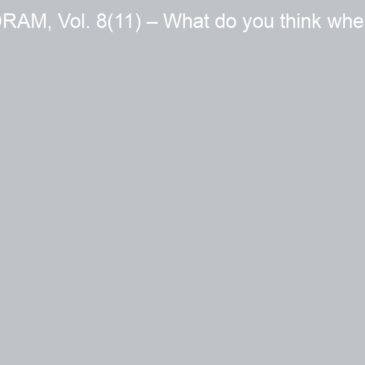People’s underlying thoughts and expectations toward drinking are related to self-reported alcohol consumption (Wiers, Van Woerden, Smulders, & De Jong, 2002). However, few previous studies have examined the effect of cognitions on actual drinking behavior in naturalistic settings. This week’s DRAM reports on a semi-naturalistic study examining the associations between implicit (i.e., not consciously elaborated) and explicit (i.e., consciously elaborated) beliefs about alcohol and observed drinking behavior (Larsen, Engels, Wiers, Granic, & Spijkerman, 2012).
Methods
- One hundred twenty-one undergraduate students (64 women) who reported drinking alcohol participated in a semi-naturalistic drinking study in the Netherlands.
- Participants completed an implicit association test (IAT) measuring implicit attitudes toward alcohol, a questionnaire on alcohol use (weekly consumption) and a measure of explicit positive expectations toward drinking (i.e., the degree to which they expected to experience various positive outcomes as a result of drinking). During the IAT task, participants had to match target concepts such as “soda” and “alcohol” to attribute concepts, such as “positive” and “negative” as quickly as possible. Positive scores indicated a stronger association between alcohol and positive attributes.
- Next, a participant and a confederate (always of the same gender) sat in a bar for a waiting period of 30 minutes. Both non-alcoholic and alcoholic drinks were available to them. A confederate drank either two sodas (control condition), or one alcoholic drink + one soda (light condition) or multiple alcoholic drinks (heavy condition). Researchers measured how many alcoholic drinks each participants consumed; this served as the outcome measure for the study.
Results
- Positive implicit associations demonstrated significant positive correlations with explicit positive expectations about alcohol (r = .25, p < .01), and with self-reported weekly drinking (r = .14; p = .05).
- The Figure displays the results of a hierarchical regression testing the prediction of observed drinking behavior from gender, implicit associations, explicit positive expectancies, weekly self-reported drinking, and the confederate’s behavior. The results primarily showed that participants drank more when
- they were with a heavy-drinking confederate (B = .52; p <.01);
- they held more positive explicit expectancies about alcohol (B = .17; p < .01).
- By contrast, implicit associations were not related to observed drinking.
- Participants in the heavy drinking confederate condition who reported high positive expectancies toward alcohol consumed more than twice as much alcohol (Malcoholic drinks consumed = 1.62, SE = .26) compared to participants with low positive expectancies in the same condition (M = .68; SE = .24), F (1,36) = 6.3, p < .01.
| Observed drinking
(B) |
|
| Gender (female) | -.12 |
| Control vs. light confederate drinking | .17 |
| Control vs. heavy confederate drinking | .52** |
| Positive implicit associations | .07 |
| Explicit positive expectancies |
.17* |
Figure. Results of hierarchical regression on the association between independent variables and observed drinking. * p < .0.05; ** p < .001 Click image to enlarge.
Limitations
- Experiments conducted in lab settings benefit from experimental controls, but the artificial environment also decreases the reality of the situation for participants potentially decreasing the generalizability of the results and the validity
of the findings. - The study used a convenience sample (students); this limits the generalizability of the results to other populations.
Conclusions
These results suggest that positive expectancies toward alcohol predict “real-life” alcohol consumption in a dyadic setting, as does peer drinking behavior. People who hold positive expectations about drinking will drink more than others, particularly when in a heavy drinking environment.
By contrast, implicit associations about alcohol do not appear to predict actual drinking behavior when positive expectations are controlled. This
implies that in social settings, individual’s expectations about drinking may be a better predictor of actual behavior than implicit attitudes. Future research could investigate whether implicit associations hold value for prediction drinking behavior in contexts where self-report might be particularly biased.
-Julia Braverman
What do you think? Please use the comment link below to provide feedback on this article.
References
Larsen, H., Engels, R. C. M. E., Wiers, R. W., Granic, I., & Spijkerman, R. (2012). Implicit and explicit alcohol cognitions and observed alcohol consumption: Three studies in (semi)naturalistic drinking settings. Addiction, 107(8), 1420-1428. doi: 10.1111/j.1360-0443.2012.03805.x
Wiers, R. W., Van Woerden, N., Smulders, F. T. Y., & De Jong, P. J. (2002). Implicit and explicit alcohol-related cognitions in heavy and light drinkers. Journal of Abnormal Psychology, 111(4), 648-658. doi: 10.1037/0021-843x.111.4.648




